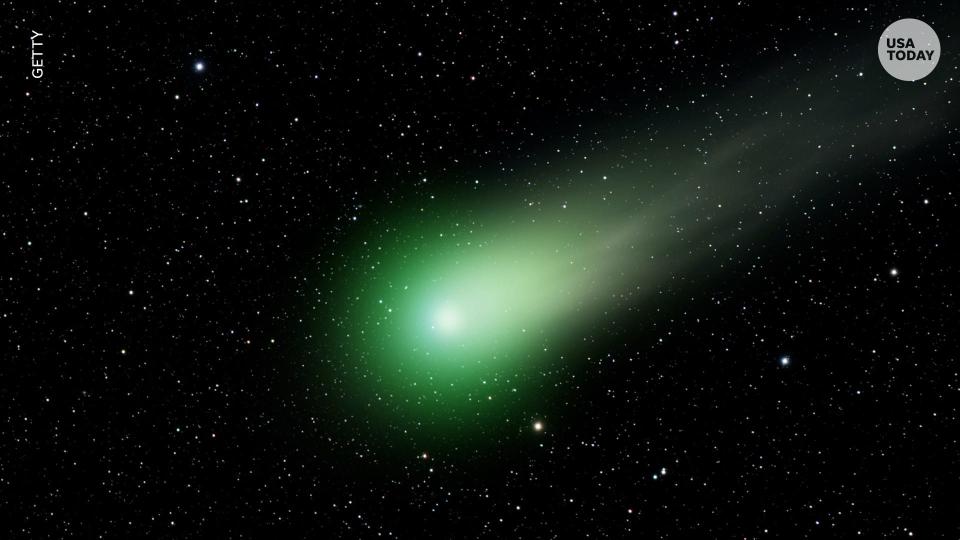Comet Nishimura will pass Earth for first time in over 400 years: How to find and watch it
A newly discovered comet will briefly illuminate the night sky before the end of the month.
This is the first time in more than 400 years that Comet Nishimura will pass by the Earth, which is about a couple decades before Galileo invented the telescope, according to The Associated Press.
Comet Nishimura was first spotted in Japan by a novice astronomer in mid-August, which is why the comet was named after him.
The comet is expected to pass Northern Hemisphere the week of September 12, passing within 78 million miles of Earth’s surface.
If the comet hasn’t been broken up by the sun, Southern Hemisphere stargazers will likely be able to observe it by September 18, according to The Planetary Society.
Here’s how to catch a glimpse of Comet Nishimura before it disappears from view for another 435 years.
What’s a comet?

A comet is a “ball of ice and rock from the outer solar system that have been flung into very elongated orbits which bring them deep into the inner solar system once in a long while,” Philip Mauskopf, a professor at the School of Earth and Space Exploration at Arizona State University shared with The Arizona Republic, part of the USA TODAY Network.
Comets are often called "dirty snowballs" because of their composition, which includes frozen water, methane and other volatile compounds mixed with dust and rocky particles, AZCentral reported.
Will Comet Nishimura be visible?
Comet C/2023 P1 (Nishimura): Such a strong solar wind. The disconnection event on September 2nd - the spectacular development in a 20-minute animation (RASA 11 QHY600) and 4x80sec red Michael Jäger pic.twitter.com/qf43YqhBbl
— Michael Jäger (@Komet123Jager) September 2, 2023
There is no guarantee Comet Nishimura will be visible, but there is a good chance it might be, NASA reported.
As the comet continues its journey towards the sun, there is a higher possibility it might be visible to the naked eye in early September, according to NASA. The comet is expected to depart from the solar system as soon as it comes in close contact with the sun on September 17, AP reported.
The nucleus of the comet may break up when it reaches the sun, but it will likely survive its passage, manager of NASA’s Center for Near-Earth Object Studies Paul Chodas shared with AP.
Since the comet is expected to approach the sun at an angle, scientists have determined that the comet will be most visible near sunrise or sunset, according to NASA.
When was Comet Nishimura discovered?
Comet Nishimura (C/2023 P1) on Sept 5, 2023. For this single shot I used my A7s and a 135mm lens.
Nishimura is a new comet that was discovered on August 11, 2023. It's expected to brighten to a magnitude of 1.8. Its closest approach to us will be on Sep 12 and its perihelion on… pic.twitter.com/BXhDo0IOpq— Dr. Sebastian Voltmer (@SeVoSpace) September 6, 2023
Hideo Nishimura was taking 30 second exposures on the night of August 11 when his digital camera captured the presence of a comet hiding in the sun’s flare, according to NASA and EarthSky.
Nishimura’s comet discovery was confirmed by the International Astronomical Union days later, according to reporting by Record Searchlight,part of the USA TODAY Network. The IAU followed the tradition of naming it after its discoverer.
C/2023 P1 Nishimura is Nishimura’s third find, which is highly unusual given the quantity of professional sky surveys by powerful ground telescopes, The Associated Press reported.
“This is his third find, so good for him,” Chodas said.
The rare green comet with a thin tail has been tracked by stargazers since its discovery, according to EarthSky and NASA.
How do I watch Comet Nishimura?
Comet C/2023 P1 (Nishimura) from Belfast, N Ireland at around 5am on 4th Sept 2023. Cropped from a 100mm image - stack of 50 x 3secs at ISO800. (Some problems with stacking caused a halo above neighbour's roof!) @martinastro2005 pic.twitter.com/jCuuZa3egN
— Philip🦎EcotrakNI (@EcotrakNI) September 4, 2023
While its incredibly likely the comet will be visible to the naked eye, the comet will be extremely faint, AP reported.
Stargazers are more likely to see the comet’s path by way of telescope or a good pair of binoculars about 90 minutes before the sun rises, according to EarthSky.
Early risers should look toward the northeastern horizon, less than 10 or so degrees above the horizon near the constellation Leo, AP reported.
“So you really need a good pair of binoculars to pick it out and you also need to know where to look,” Chodas told AP.
Spotting the comet will become increasingly difficult after this week as it gets closer to the sun and drops closer to the horizon.
This article originally appeared on USA TODAY: New Comet Nishimura could be viewed passing Earth after 435 years

